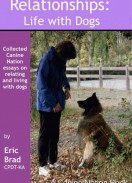 I’ve always been fond of the old saying that we should “Work smarter, not harder.” There are lots of pursuits where the results you get are directly related to the amount of effort you put into the job. Training a dog is not one of those things, at least in my experience. I know people who train much more with their dogs than I do and they don’t achieve results that are much better than mine. Don’t get me wrong, It’s not that they don’t get good results; some of them get great results. It’s just that I seem to be able to get the similar results with much less effort. Let me explain.
I’ve always been fond of the old saying that we should “Work smarter, not harder.” There are lots of pursuits where the results you get are directly related to the amount of effort you put into the job. Training a dog is not one of those things, at least in my experience. I know people who train much more with their dogs than I do and they don’t achieve results that are much better than mine. Don’t get me wrong, It’s not that they don’t get good results; some of them get great results. It’s just that I seem to be able to get the similar results with much less effort. Let me explain.
I knew a trainer years ago when I started training my dog for dog agility. This trainer had a very ambitious agility training routine for her dog. At least 15 minutes of training in the morning, again at lunch, and then in the evening every single day. By contrast, I only worked with my dog on agility training once a week for 10 or 15 minutes. The simple arithmetic would be that she trained for 5 hours and 15 minutes each week compared to my 15 minutes of work. Logically, I would expect her dog to have learned more than mine or faster than mine or be more fluent more quickly than mine given the extra training. The truth of it was that they might have gotten great results but nothing that would look like she did 5 hours more training each week than I did. There was just not that much difference in our results.
Motion does not equal progress
One of the advantages I had when I began training for agility is that I was new to science based training. I was unfamiliar with many of the concepts and techniques involved. So I had to carefully consider what I was doing during training and to go slowly to be sure I was doing the training correctly. One of the big lessons that I learned from Mark and Reward Training (Clicker Training) was that it was important to go into each training session prepared and to be efficient. It seemed like an updated version of a saying my grandfather used to tell me, “Practice doesn’t make perfect. Perfect practice makes perfect!” Sometimes doing more doesn’t necessarily produce more.
Over the years, the time I spent training agility came down to about 3 minutes per week and we still had great results (my dog has multiple agility championship titles). Even at home, we spent less than 10 minutes per day working on learning new behaviours or practicing behaviours I had already taught my dog. I began to wonder why I was able to spend so much less effort to get my results while others seemed to work so much harder and not be as happy with their results. There are differences in dogs and training methods to be sure but maybe it had something to do with how I was doing it. And then I ran across this great quote from B.F. Skinner, one of the great pioneers of reward based training, “The way positive reinforcement is carried out is more important than the amount.”
You get what you pay for
I remember attending a lecture by Karen Pryor back in 2004. She cautioned us during her talk about the dangers training for the sake of training; that kind of rote practice where we work with the dog each day because we’re “supposed to.” Pryor explained that setting up a schedule and going through a training routine day after day can cause us to lose focus on maintaining good technique and criteria for rewarding the behaviours. It’s easy lull ourselves into accepting small variations of the behaviours. We can decide that “that was good enough” because we’ve done this a hundred times and we’re thinking about other things at the same time. Then a month or two later, we notice this funny variation in the dog’s behaviour when we give her a familiar cue. And then wonder where the heck that came from!
 It won’t matter how much I train with my dog if I’m not focused on what I’m doing. I think the trouble comes from the repetitive nature of working with my dog. This is especially true for behaviours we have practiced many times. It can be easy for me to fall into “automatic” mode where I’m not as mindful of what I’m doing as I should be. Doing more training just means more opportunities for me to slack off. I manage this by limiting myself to only so much training time. I find that this makes me mindful and effective. I have to pay attention to the details when I work with my dog if I want to get the job done.
It won’t matter how much I train with my dog if I’m not focused on what I’m doing. I think the trouble comes from the repetitive nature of working with my dog. This is especially true for behaviours we have practiced many times. It can be easy for me to fall into “automatic” mode where I’m not as mindful of what I’m doing as I should be. Doing more training just means more opportunities for me to slack off. I manage this by limiting myself to only so much training time. I find that this makes me mindful and effective. I have to pay attention to the details when I work with my dog if I want to get the job done.
The prepared mind
One thing that has been a great help in keeping me focused on my training is making sure I’m prepared before I begin working with my dog. I learned early on that going in to work with my dog without having a plan can be a recipe for all kinds of problems. If I’m not clear in my own mind what I am working on, how is my dog supposed to know? The first books I read on Mark and Reward training were careful to stress the importance of things like criteria, training plans, and having all the tools for training ready before starting to work with the dog. In her excellent book “Training Levels – Steps to Success Vol. 1” Canadian trainer Sue Ailsby writes, “Not being ready is worse than wasting your time and the dog’s. Not being ready means that you may be teaching the dog things you didn’t want her to know…” And everything unwanted thing your dog learns is something you have to get her to unlearn.
I have something of a simple checklist before I start a training session: What are my goals? What are my success criteria for each step (what does “right” look like)? Am I clear on the steps I want to teach? How long will I work? Do I have all of the prompts I need for this session? Do I have my markers and rewards? Being prepared goes beyond my own needs and desires for training as well. I need to consider whether this might be the best time to train with my dog. (Is she sleepy or not very hungry or tired from exercise?) I also need to consider whether the environment where I want to train is appropriate. (Is it too noisy or distracting? Are there other things that my dog would find more attractive than working with me?) Taking the time to prepare helps me focus on my dog.
Technique matters
Training can be a deceptively simple process. See the behaviour you want. Mark that behaviour you want. Reward the dog for that behaviour. Regardless of what you are teaching your dog, each of those simple steps is critically important and a good trainer will devote their full attention to each of them. If I’m not paying attention, my dog may offer me the behaviour I want and I don’t see it. If I’m not properly focused, the timing of my marker may be early or late and I could mark the wrong behaviour. And if I’m not attentive enough to make sure I reward my dog properly, my efforts could all be in vain. It can be deceptively easy to miss every now and then but it only becomes a problem if it becomes a habit.
 The bottom line is that training is a mechanical process. It is a set of skills that I can learn to improve. Learning to do them well means giving attention to the details while I am using them. I can’t be inconsistent in my performance and then expect my dog to be consistent. I don’t help myself or my dog by slacking off on my technique. Sadly, I can’t make up for it by just doing more training because that just gives me more opportunities to mess up. If I don’t have the discipline to plan out and prepare my part of the training sessions, how can I expect my dog have great performance?
The bottom line is that training is a mechanical process. It is a set of skills that I can learn to improve. Learning to do them well means giving attention to the details while I am using them. I can’t be inconsistent in my performance and then expect my dog to be consistent. I don’t help myself or my dog by slacking off on my technique. Sadly, I can’t make up for it by just doing more training because that just gives me more opportunities to mess up. If I don’t have the discipline to plan out and prepare my part of the training sessions, how can I expect my dog have great performance?
The answer to a training problem might not be doing more training. It might not be changing methods or techniques. For me, going back to basics and making sure I am doing the best I can to prepare and use the techniques I’ve been taught. Sometimes that means having a friend watch or using video to evaluate how I’m doing during my training sessions. Could I be working smarter instead of harder? The answer is often “Yes!”
How we train our dogs is often more more important than how often we train our dogs.
Until next time, have fun with your dogs!
Be sure to check out our Canine Nation ebooks in the Canine Nation store and Dogwise. Join our conversation on Facebook in the Canine Nation Forum!
These Canine Nation ebooks are now available –
Photo credits –
Smart Dog – copyright Bill Way 2013 from Flickr
Puppy – copyright Dave C 2009 from Flickr
Training -copyright Andrea Arden 2013 from Flickr





I couldn’t disagree more!! This, of course, is based only on my own experience, but I train my three dogs every day, and if I am trying to teach a new behavior, sometimes I train that behavior more than once a day. I work at home, and our training sessions are mostly play, and the dogs certainly view it as such. They are not nose-to-the-grindstone, serious, get that behavior perfect sessions, they are play. I want my dogs to view agility as the wonderful game we all play together, and our daily sessions are my reward for working all day and their reward for being ignored all day. Not that we don’t work on technique, we certainly do, and my dogs have multiple championship titles. I can’t think of any sport (and this is a real sport that needs excellent technique and physical conditioning) where fifteen minutes a week would do it, whether tennis, rock climbing, baseball, you name it. The handler needs the practice to develop coordination and speed, the dog needs it too. And, from the dog’s point of view (and mine) it is PLAY!